The MSI B450 Tomahawk Motherboard Review: More Missile Than Axe
by Gavin Bonshor on December 11, 2018 8:00 AM EST- Posted in
- Motherboards
- AMD
- MSI
- Zen
- AM4
- Ryzen
- Tomahawk
- Ryzen 2
- B450
- Entry Level
- MSI B450 Tomahawk
_678x452.jpg)
From the few second-generation AMD B450 and X470 motherboards we have tested, the majority have been refreshed models of pre-existing boards. Over time, the vendors have had the opportunity to make minor tweaks and upgrades to keep ahead of current technological advances and inevitable design choices. MSI has tried to tick both boxes with the new B450 Tomahawk which comes with an extended CPU heatsink, USB 3.1 Gen2 support and RGB LEDs.
The MSI B450 Tomahawk Overview
The MSI B450 Tomahawk is the successor to the popular B350 Tomahawk and offers users a slightly better feature set. This starts with including a pair USB 3.1 Gen2 ports, as well as customizable RGB LED lighting integrated into the board. The B450 Tomahawk is a gaming-themed motherboard and comes from MSI’s ‘Arsenal’ range of motherboards designed to offer users an affordable option with many of the features found on the more expensive models, but with some differentials to keep the overall cost down. This includes the pairing of decent quality and cost-effective Realtek controllers on audio side and the networking side.
One of the most beneficial performance aspects to consider this model over the previous Tomahawk is the increased official memory support. The B450 Tomahawk now has support DDR4-3466 with a maximum capacity of up to 64 GB across four available memory slots. Storage capability is better than expected from a B450 motherboard, with a total of six SATA ports capable of supporting RAID 0, 1 and 10 arrays. On top of this is a single PCIe 3.0 x4 and SATA capable M.2 slot with a maximum of up to M.2 22110 drives being supported. The single M.2 slot doesn’t share bandwidth with any other PCIe slot but populating the slot with a drive will however disable two of the six available SATA ports; specifically the two right-angled ports closest to the 24-pin motherboard ATX power input.
On the rear panel, MSI now includes a pair of USB 3.1 Gen2 ports, one Type-A and one Type-C. There is also two USB 3.1 Gen1 Type-A ports, and two USB 2.0 ports, with an option to increase the USB options by a further two and four respectively with internal headers. Video outputs from any integrated graphics can be made through a DVI-D port or an HDMI 1.4 port. A single PS/2 combo mouse and keyboard port is also present. The single LAN port is powered by a Realtek RTL8111H Gigabit networking controller and the six gold plated 3.5 mm audio jacks takes its direction from a middle of the road Realtek ALC892 HD audio codec. MSI has included a BIOS Flashback+ button on the rear panel for a quick and easy experience when updating the board's firmware.
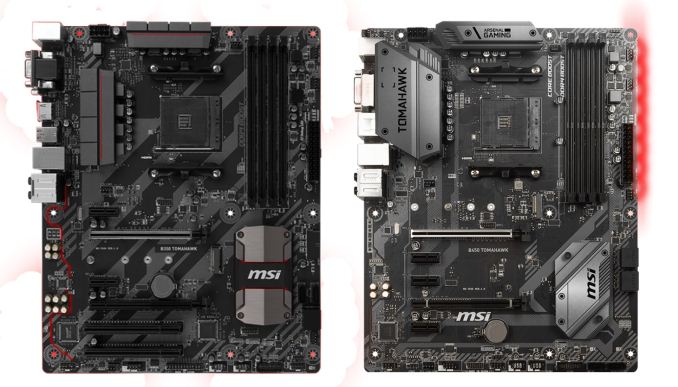
The MSI B350 Tomahawk (left) and MSI B450 Tomahawk (right)
One of the biggest visual differences between the B350 and B450 Tomahawk are the heatsinks and the PCIe implementation. The B450 Tomahawk has a total of five PCIe slots with one full-length PCIe 3.0 x16 slot with a coating of MSI’s Steel Armor slot protection, a full-length PCIe 2.0 x4 slot, and three PCIe 2.0 x1 slots which takes up most of the space on the bottom half of the board. The power delivery heatsinks have also been upgraded with the heatsink covering the MOSFETs and extending further over towards the rear IO. The newer heatsinks have a cleaner and futuristic look, but with a lighter grey finish. Other differences include the SATA port implementation.
When looking at the overall performance of the B450 Tomahawk, the most positive points to highlight come in the power consumption testing where the 2W idle power draw of the B450 chipset clearly plays a big part. Even at maximum load the B450 Tomahawk even manages to do well with one of the lowest maximum power draws seen from an AM4 board so far. The general performance throughout the compute and rest of the system based tests is around average for an entry-level option, which is more than acceptable for most systems. Unfortunately the less that impressive audio is a mark against the board.
The overclocking performance however was much better, with a solid 4+2 phase power delivery around the commonly used Richtek RT8894A PWM controller. This seems to have paid dividends for MSI, as the tight Vdroop control was favorable.
The MSI B450 Tomahawk has an MSRP of $110 which is a $20 increase over the release MSRP of the B350 Tomahawk. This cost can be attributed to the addition of RGB LEDs integrated into the board, as well as the inclusion of two USB 3.1 Gen2 ports. The B450 Tomahawk is widely available and can have a sale price of sub-$100 at Newegg, which makes it a lot more competitive in a currently crowded B450 motherboard market.


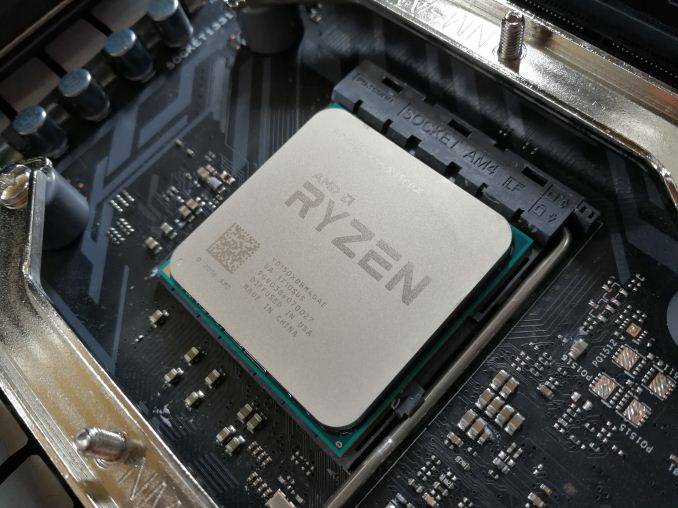

%20-%20Copya_678x452.jpg)
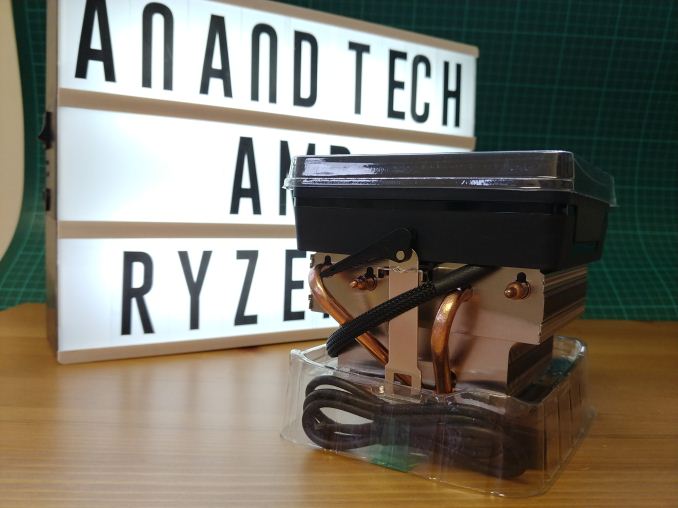
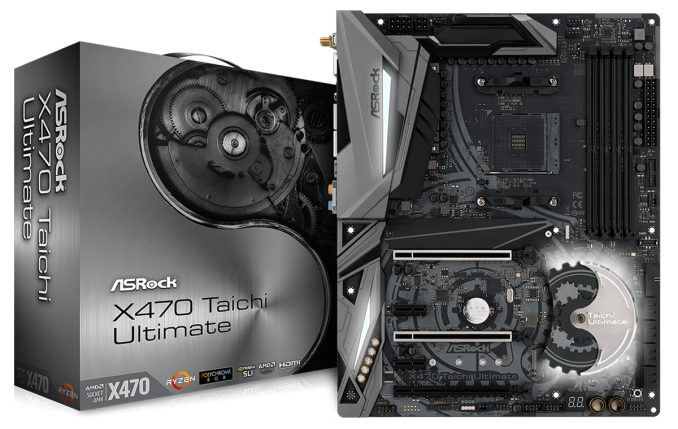
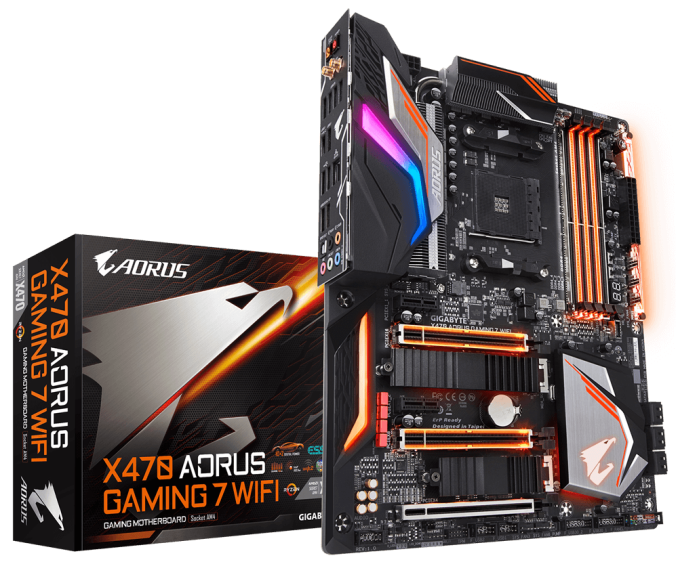
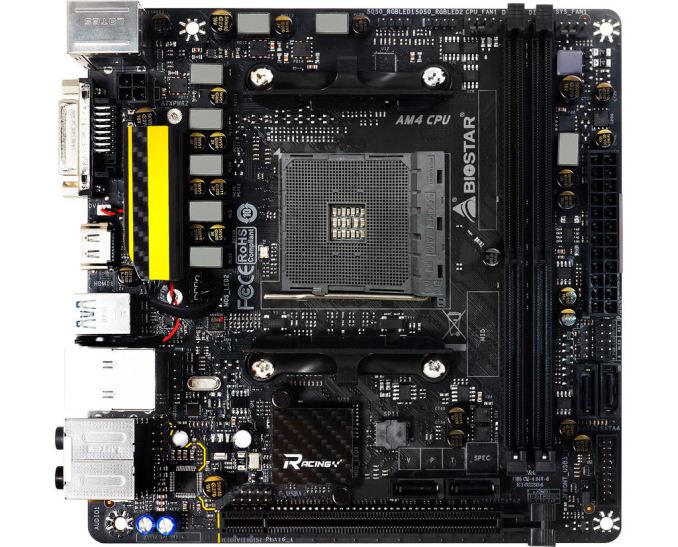
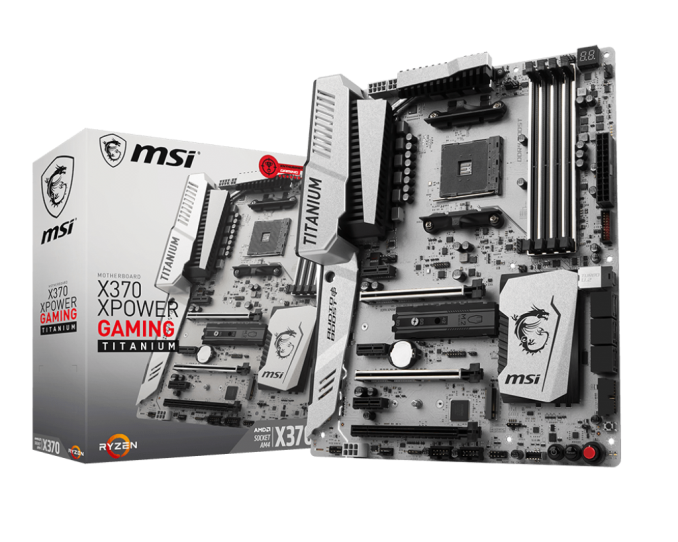
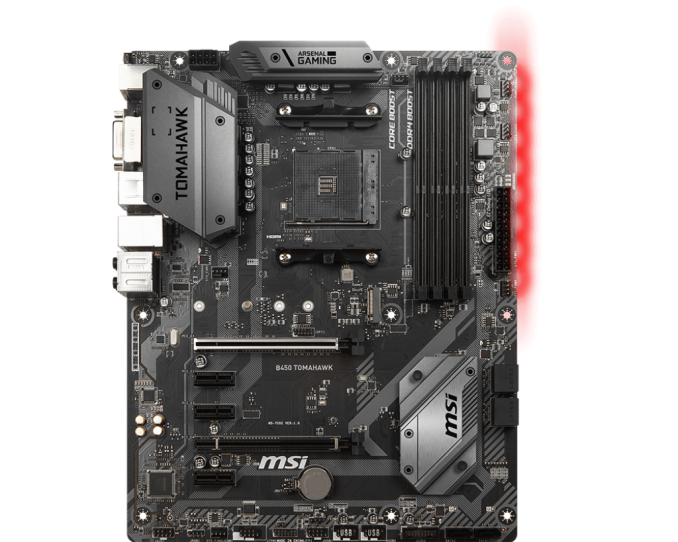









36 Comments
View All Comments
DrHansGruber - Tuesday, December 11, 2018 - link
Gaming performance looks like it's taken a not insignificant hit compared to the B350 Tomahawk.gavbon - Tuesday, December 11, 2018 - link
That does seem to be the current trend from X370/B350 to X470/B450 from the testing. It's still within a 1-3% margin of error although more like 7% in Total War. This could be the developer changing the benchmark slightly with a game update which would make more sense, given the other gamers tested are more in line with other boards.ianrumford - Tuesday, December 11, 2018 - link
A cautionary tale.I just bought this board during Black Friday sales (~£90). Nice spec and good price. But.
It came with the 120 bios installed but didn't recognise both 16GB sticks of my
G.Skill 3200 Trident Z for AMD ("TZRX"). I got the board to boot with just one stick though at 2133.
The latest bios (130) includes support for AGESA 1.0.0.6 which has better memory compatibility.
I used the bios m-flash utility to upgrade to 130 and all seemed well till
around 70% when I was briefly called away and returned to find a blank screen. The board did not boot.
The Tomahawk has a well-advertised feature call BIOS Flashback where you can recover the bios
using the special hardware port that takes a FAT32 usb with the bios on it.
The marketing collateral on Newegg says of BIOS Flashback:
"Run into trouble when updating your BIOS? Simply flash the old BIOS version
back and continue gaming within minutes with BIOS Flashback+. BIOS Flashback+
even works without a CPU, memory or graphics card installed!"
But the board refused to even load the 130 bios. Googling around this seems to suggest
there is something wrong with the bios file.
I tried to (re)load the 120 bios using flashback. This bios loaded in the way the
manual says it should, but the board still did not boot.
I've tried the other two bioses available on the MSI website and while they seem
also to load ok, still no joy.
I opened a call with MSI tech support and they have confirmed pretty much that
BIOS Flashback does not always work.
I've contacted the reseller to negotiate a replacement. In UK law a product that
does not do what it claims to be able to do is not of "merchantable quality".
gavbon - Tuesday, December 11, 2018 - link
Sorry to hear you've had that experience! It sounds more like a straight RMA and swap to me, but obviously, I cannot speak on behalf of the manufacturer. If I had the same issue which these things can happen, I would RMA too. Where did you buy it from? Are they willing to replace the board?ianrumford - Tuesday, December 11, 2018 - link
Hi,
I'd rather not say at this point who the reseller until they have had a chance
to step up to the plate. I think they are UK-only. I've bought from them before
and they gave good prices and good service although I've never had to return
anything.
There are a few observations I'd make though, two MSI-specific and one more
general.
First is the MSI marketing folk are over-egging the product in a way the tech
folk can't deliver on.
Second is their testing of new bioses: the latest (130) bios failed for me both to
flash and even be recognised as valid for flashback.
Third is the more general point of how fraught bios update still seems to be.
Its been a while since I built a new system but have been surprised how many
reports there are of updates failing, even though technologies like dual bios
and flashback have become more common. That's qualitative of course and I've
never seen any stats on update failures. Also I've never written any code for
hardware so have no idea of the challenges faced writing an utterly paranoid
update process. Perhaps the development and/or testing time is just too
expensive and maybe its cheaper for manufacturers just to take the hit on RMAs.
Wingartz - Tuesday, December 11, 2018 - link
i had an issue like that also with MSI but the X58 mobo (damn those mobos) flashed via usb to the newest version and it bricked right away, searched in Google and found that specific model always got bricked when flashing via usb, it seems after all this years they have't got the issue solvedplonk420 - Friday, December 14, 2018 - link
wowch, that was an expensive board to brickrocky12345 - Monday, December 17, 2018 - link
That is why I like boards like Gigabyte and their dual bios because if something goes wrong you just flip the switch and are up and running again. On my own Gigabyte board my second bios is something like version 1 since I have never flashed the second bios on it ever just the main bios which has always worked like a charm so far.OolonCaluphid - Wednesday, December 12, 2018 - link
I have the MSI B450m Mortar - the mATX little brother for this board.I also have absolutely no joy getting it to play with my DDR4 3200mhz ram - Kingston Hyper X. It works perfectly with my 32gb 3000Mhz Kingston Hyper X kit, however. So I refuse to believe claims that these boards support 3466Mhz ram, unless it's on the QVL list and also you get a bit lucky.
Sound quality is also poor, but that's not a problem for my uses.
Sorry to hear of your BIOS problems. real PITA. Here's hoping the retailer see you right.
3DoubleD - Wednesday, December 12, 2018 - link
I'd second that. I really think Anandtech should run an article on this because it took me a bit by surprise, although I had heard of compatibility issues.I recently put together a Ryzen 2600x + Gigabyte Gaming 7 + 2x16GB DDR3200 system and what a pain it is to get memory running at the correct speeds. I even carefully grabbed a RAM kit that was listed on Gigabyte's qvl list for the board at the rated speed, but even after bios update the XMP did not boot.
Eventually I used one of the Ryzen ram timing calculators and got it to boot at 3200 MHz, but I had some stability issues so I dropped to 3133 MHz with slightly faster timings (probably not much of a performance tradeoff).
Apparently you need to buy Samsung B-die dimms, but I had a really hard to finding any during black friday sales and got a good deal for the kit I ended up buying (that was supposedly tested by Gigabyte at the rated speed and timings).
Anyway, a RAM buyers guide for AMD systems would be worthwhile IMO because it is NOT as straightforward or plug & play as you'd think it would be in 2018 (almost 2019).